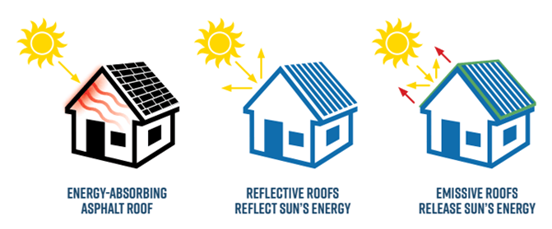Summer is right around the corner, and with temperatures heating up, we are all looking for ways to cool down. A question we are often asked this time of year is, “Do metal roofs make a home hotter in the summer”? This question focuses on whether a metal roof absorbs more heat than a non-metal roof, increasing the warmth within your home. The answer is simple: a metal roof does not make your home hotter in the summer.
 Numerous metal roofing options incorporate reflective coatings that redirect sunlight, reduce heat absorption, and maintain a cooler indoor environment. This reduces dependence on air conditioning in hot months, potentially leading to lower energy consumption and cost savings.
Numerous metal roofing options incorporate reflective coatings that redirect sunlight, reduce heat absorption, and maintain a cooler indoor environment. This reduces dependence on air conditioning in hot months, potentially leading to lower energy consumption and cost savings.
How it Works
- Low Thermal Mass: Metal roofs are made of materials with low thermal mass, meaning they don’t store and hold heat as effectively as slate or concrete, which have higher thermal mass. This characteristic allows metal roofs to respond quickly to changes in temperature. You can read more on thermal mass here.
- Heat Absorption: Asphalt shingles can absorb a significant amount of heat from the sun due to their higher thermal mass. These shingles are constructed using petroleum asphalt and mineral granules; these dense, black substances tend to absorb more solar heat. During the summer, bare metal might reach temperatures around 145 degrees, whereas black asphalt shingles can soar to 168 degrees. This absorbed heat can slowly spread into your home, potentially increasing indoor temperatures and the need for air conditioning.
- Reflectivity: Metal roofs are often reflective, which means they can bounce back a significant portion of the sunlight that hits them. This reflection helps reduce the heat the roof absorbs. The reflective property can contribute to keeping your home cooler and more energy-efficient, especially in hot climates.
- Cool Roof Effect: Because of their reflective properties, metal roofs are often considered part of a “cool roof”. Cool roofs are designed to reflect more sunlight and absorb less heat than standard roofs. Research findings indicate that you can reduce your cooling expenses and qualify for money-saving utilities by opting for a cool metal roof.

Colors and Coatings
The color and coating on a metal roof can significantly affect how much heat it absorbs. Providing a range of high-quality coating systems, like Kynar 500®, is important to us at McElroy Metal. In order to offer the best possible performance options, we partner with Sherwin Williams®, a distinguished industry leader in coil coatings, to serve as our preferred coatings supplier. It should be noted that lighter colors are more effective in reflection and energy savings than dark colors. However, it’s important to mention that even dark metal is a better choice when compared to shingles.
Insulation Materials
While color and coatings contribute to a roof's heat, insulation also helps protect the roof and the occupied space. Insulation also reduces noise during heavy rain, hail, and extreme wind. Insulation with vapor barriers decreases moisture and a number of common roofing problems. When it comes to insulation for metal roofs, there are a number of options available, like fiberglass batts, rigid foam boards, and spray foam insulation.
At its core, a metal roof with reflective coatings can make your home feel cooler when compared to a home with shingles. The improved coolness doesn’t come from its insulating properties but from its ability to redirect heat away from your home. As a result, it can keep your home cool in those hot summer months and help you save money.
About McElroy Metal
Since 1963, McElroy Metal has served the construction industry with quality products and excellent customer service. The employee-owned components manufacturer is headquartered in Bossier City, La., and has 14 manufacturing facilities across the United States. Quality, service and performance have been the cornerstone of McElroy Metal’s business philosophy and have contributed to the success of the company through the years. As a preferred service provider, these values will continue to be at the forefront of McElroy Metal’s model along with a strong focus on the customer.




.png?width=767&name=Metal%20Roofing%20for%20Event%20Centers,%20Arenas%20%20&%20Sports%20Facilities%20(1).png)



Comments on this article:
Scroll down to the bottom to submit a comment and join the conversation. Need help or have a question? Please contact us. Looking for a distributor or contractor? Please click here to get started.